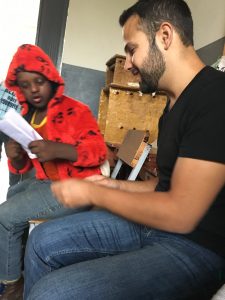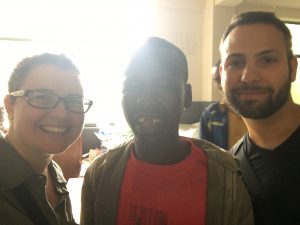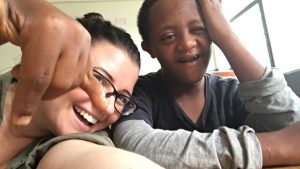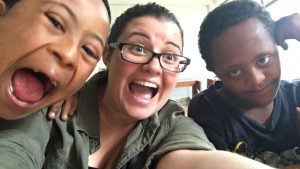This week we were fortunate enough to have the opportunity to be a part of the Special Needs Program at KokeTsiba Primary School. My experience as an SEA prepared me for what we were going to see and experience. I went into the school with slight trepidation. I was unsure what exactly we were going to encounter. Would the student’s needs be being met? Would there be an overwhelming amount of students with not enough support? How would the physical space be organized? What was I going to walk into?

 When we arrived the students were taking part in physical activity on the school field. We were shown the various empty classrooms and then invited to observe the students on the field. We sat down on the cement bleachers and the first I noticed were the smiles and looks of joy on each student’s face. They were all on the field playing various team and individual games. Some were distracted by our presence but after a quick wave and hello, they went right back to their activities. As we were sitting there a couple of students came and went. And each time they passed us by they would greet us with a handshake and ‘Hello, how are you?’. One non-verbal girl passed Leanne and myself and then stopped in front of Grant. She looked him in the eyes and then rubbed her hands on his cheeks, feeling his beard. Before walking on she gave him a little hug and a smirk. Once PE was over all the students passed us by on their way back to class. One by one they shook our hands and said hello. The teachers were present but all of the students were making their way back to class unassisted.
When we arrived the students were taking part in physical activity on the school field. We were shown the various empty classrooms and then invited to observe the students on the field. We sat down on the cement bleachers and the first I noticed were the smiles and looks of joy on each student’s face. They were all on the field playing various team and individual games. Some were distracted by our presence but after a quick wave and hello, they went right back to their activities. As we were sitting there a couple of students came and went. And each time they passed us by they would greet us with a handshake and ‘Hello, how are you?’. One non-verbal girl passed Leanne and myself and then stopped in front of Grant. She looked him in the eyes and then rubbed her hands on his cheeks, feeling his beard. Before walking on she gave him a little hug and a smirk. Once PE was over all the students passed us by on their way back to class. One by one they shook our hands and said hello. The teachers were present but all of the students were making their way back to class unassisted.

The students were of varying needs, both physical and developmental. They were divided into 4 different classes, A, B, C, & D: A was for the more capable students, B for students who required a little more support, C for new students entering the program and students with severe needs, D was vocational studies. We had the opportunity to sit in on A class. We sat among the students at the back of the room. The students were focusing on parts of the body in English. It was an interactive lesson where the students would show a part of the body and what its function was. They also worked on math; adding and subtracting one digit numbers. The teacher had a way with the students. It’s hard to describe but the class was calm and all of the students were very responsive to what was happening. The older students would instruct the younger students when they were acting out. The class all worked together to maintain the level of calm and to teach one another. All of the students wanted to participate and even the non-verbal students were engaged and participating. The students were learning from not only the teacher but the other students in the room.


On Thursday we had the opportunity to head to a rural community 80km outside of Addis. Although the drive was long, there was so much to see along the way. Before we left we had talked with friends about where we were going and what we wanted to see. We had mentioned wanting to see different animals but we had already seen so many in the city that we didn’t think we would see anything new. They quickly informed us that oh there is a difference – there are city donkey and country donkey. We would know the difference.
We traveled with two representatives from CODE Ethiopia. We went to a community library and a secondary school. The CODE representatives wanted to investigate how the libraries were running and what the students thought of the materials that were present. They asked the students many questions around what kind of books they like to read, what they don’t like to read, if they could have any book what would it be, what subject areas they like reading about. Many of the student’s responses centred around textbooks and reading in preparation for exams. In the Ethiopian culture they do not have a lot of time to sit and read. Their tradition is an oral history. Because of this, many adults have passed onto their children the importance of oral history but not the written word. It was interesting to know that many of the students only read the material that is going to further their education, not books for pleasure. One question that I had difficulty with was when the CODE representative asked if the students preferred o read in English or their native tongue. For me, the answer was quite simple. Of course the students would rather read in their native tongue. The stories would hold more meaning for them and they wouldn’t be work. While many of the students are fluent in English, it is much different to speak and write in English than it is to read a novel for pleasure. It was also interesting to note that the students were not able to check the books out. If they wanted to read a book they had to sit in the library to do so. I believe that would be another barrier to students reading for pleasure. It is difficult to read a whole novel in one sitting and how are they to know if that book is going to be available the next time they come into the library? Overall, it was an interesting day. I learned a lot about the number of diverse communities and cultures that make up Ethiopia and that being attuned to students diverse backgrounds enables us to better facilitate their learning.
The journey with the CODE ladies also helped me to appreciate more where we are staying and our willingness to take risks. We have taken to saying “Whatever happens, happens – we are in Ethiopia!” We have been willing to get out of our comfort zone and try new things, which has made this trip more of an adventure and enabled us to see more of what Ethiopia has to offer.
On Friday we had the opportunity to take one of the teachers from KokeTsiba out for lunch. He mentioned the phrase “Sharing is happiness” and I believe that it sums up the the Ethiopian culture. Everyone is very open and friendly. They are quick to offer you a helping hand or a friendly conversation. Meals are also a time of sharing. We have found that Ethiopian meals are never a quick bite. Lunch usually lasts a few hours and you order a big plate to share. You always feel welcome in Ethiopia and we have made some lasting friendships so far in our two short weeks.

Sara, this was a very detailed description that made me feel I was there with you-thank you! Many of you in other countries point out the behaviour in the classroom-children that are happy to be there, attentive, a spirit of sharing and warm, and so on. It is interesting to speculate on how the community views education and functions as a whole doing activities together etc. changes the tone of the classroom and the concentration levels of the students! Thank you for this interesting reflection!
Kerri